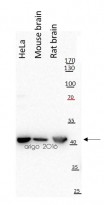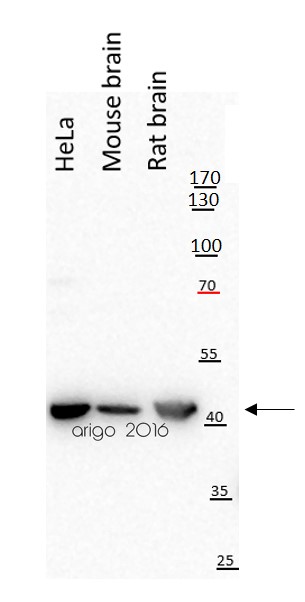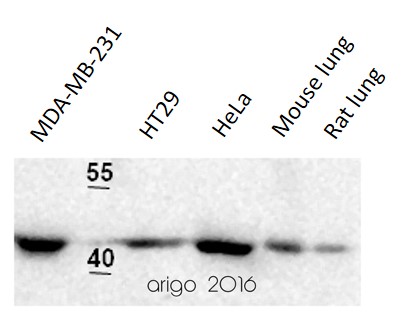ARG62346
anti-beta Actin antibody [BA3R]
anti-beta Actin antibody [BA3R] for ELISA,Flow cytometry,ICC/IF,Immunoprecipitation,Western blot and Human,Mouse,Rat,Chicken,Rabbit
Controls and Markers antibody; Signaling Transduction antibody; Loading Control antibody; Cytochrome-C fractionation Study antibody; Inflammation Study antibody; Tag Internal Control antibody

概述
| 产品描述 | Mouse Monoclonal antibody [BA3R] recognizes beta Actin |
|---|---|
| 反应物种 | Hu, Ms, Rat, Chk, Rb |
| 应用 | ELISA, FACS, ICC/IF, IP, WB |
| 特异性 | Recognizes native and denatured forms of β-Actin (around 42 kDa) |
| 宿主 | Mouse |
| 克隆 | Monoclonal |
| 克隆号 | BA3R |
| 同位型 | IgG2b |
| 靶点名称 | beta Actin |
| 抗原 | β-Actin N-terminal peptide-KLH conjugates. |
| 偶联标记 | Un-conjugated |
| 別名 | PS1TP5BP1; BRWS1; Actin, cytoplasmic 1; Beta-actin |
应用说明
| 应用建议 |
|
||||||||||||
|---|---|---|---|---|---|---|---|---|---|---|---|---|---|
| 应用说明 | * The dilutions indicate recommended starting dilutions and the optimal dilutions or concentrations should be determined by the scientist. | ||||||||||||
| 阳性对照 | Mouse brain |
属性
| 形式 | Liquid |
|---|---|
| 纯化 | Protein A affinity purified. |
| 纯化说明 | Protein A affinity chromatography from mouse ascites fluid. |
| 缓冲液 | 10mM PBS (pH 7.2) and 0.05% Sodium azide |
| 抗菌剂 | 0.05% Sodium azide |
| 浓度 | 1 mg/ml |
| 存放说明 | For continuous use, store undiluted antibody at 2-8°C for up to a week. For long-term storage, aliquot and store at -20°C or below. Storage in frost free freezers is not recommended. Avoid repeated freeze/thaw cycles. Suggest spin the vial prior to opening. The antibody solution should be gently mixed before use. |
| 注意事项 | For laboratory research only, not for drug, diagnostic or other use. |
生物信息
| 数据库连接 | |
|---|---|
| 全名 | actin, beta |
| 背景介绍 | Beta actin is one of six different actin proteins. Actins are highly conserved proteins that are involved in cell motility, structure, integrity, and intercellular signaling. The encoded protein is a major constituent of the contractile apparatus and one of the two nonmuscle cytoskeletal actins that are ubiquitously expressed. Mutations in this gene cause Baraitser-Winter syndrome 1, which is characterized by intellectual disability with a distinctive facial appearance in human patients. Numerous pseudogenes of this gene have been identified throughout the human genome. [provided by RefSeq, Aug 2017] |
| 生物功能 | Actin is a highly conserved protein that polymerizes to produce filaments that form cross-linked networks in the cytoplasm of cells (PubMed:29581253). Actin exists in both monomeric (G-actin) and polymeric (F-actin) forms, both forms playing key functions, such as cell motility and contraction (PubMed:29581253). In addition to their role in the cytoplasmic cytoskeleton, G- and F-actin also localize in the nucleus, and regulate gene transcription and motility and repair of damaged DNA (PubMed:29925947). [UniProt] |
| 细胞定位 | Cytoplasm , cytoskeleton |
| 产品亮点 | Related Antibody Duos and Panels: ARG30003 Tag Internal Control Antibody Duo (DDDK tag, beta Actin) Related products: beta Actin antibodies; beta Actin Duos / Panels; Anti-Mouse IgG secondary antibodies; |
| 研究领域 | Controls and Markers antibody; Signaling Transduction antibody; Loading Control antibody; Cytochrome-C fractionation Study antibody; Inflammation Study antibody; Tag Internal Control antibody |
| 预测分子量 | 42 kDa |
| 翻译后修饰 | ISGylated. Oxidation of Met-44 and Met-47 by MICALs (MICAL1, MICAL2 or MICAL3) to form methionine sulfoxide promotes actin filament depolymerization. MICAL1 and MICAL2 produce the (R)-S-oxide form. The (R)-S-oxide form is reverted by MSRB1 and MSRB2, which promote actin repolymerization (By similarity). Monomethylation at Lys-84 (K84me1) regulates actin-myosin interaction and actomyosin-dependent processes. Demethylation by ALKBH4 is required for maintaining actomyosin dynamics supporting normal cleavage furrow ingression during cytokinesis and cell migration. (Microbial infection) Monomeric actin is cross-linked by V.cholerae toxins RtxA and VgrG1 in case of infection: bacterial toxins mediate the cross-link between Lys-50 of one monomer and Glu-270 of another actin monomer, resulting in formation of highly toxic actin oligomers that cause cell rounding (PubMed:19015515). The toxin can be highly efficient at very low concentrations by acting on formin homology family proteins: toxic actin oligomers bind with high affinity to formins and adversely affect both nucleation and elongation abilities of formins, causing their potent inhibition in both profilin-dependent and independent manners (PubMed:26228148). |
检测图片 (7) Click the Picture to Zoom In
-
ARG62346 anti-beta Actin antibody [BA3R] ICC/IF image
Immunofluorescence: 100% Methanol fixed (RT, 10 min) HeLa cells stained with ARG62346 anti-beta Actin antibody [BA3R] at 1:500 dilution. Left: primary antibody (green). Right: Merge (primary antibody and DAPI).
Secondary antibody: ARG55393 Goat anti-Mouse IgG (H+L) antibody (FITC)
-
ARG62346 anti-beta Actin antibody [BA3R] WB image
Western blot: MCF-7, A549, H1299, HCT116, HepG2 and HUVEC cell lysates stained with ARG62346 anti-beta Actin antibody [BA3R] at 1:1000 dilution.
-
ARG62346 anti-beta Actin antibody [BA3R] WB image
Western blot: Rat brain, Rat heart, Rat kidney, Rat stomach and Rat ovary lysates stained with ARG62346 anti-beta Actin antibody [BA3R] at 1:1000 dilution.
-
ARG62346 anti-beta Actin antibody [BA3R] WB image
Western blot: 20 µg of HeLa, Mouse brain and Rat brain lysates stained with ARG62346 anti-beta Actin antibody [BA3R] at 1:10000 dilution.
-
ARG62346 anti-beta Actin antibody [BA3R] WB image
Western blot: Mouse heart stained with ARG62346 anti-beta Actin antibody [BA3R].
From Lei Zhang et al. Front Physiol (2022), doi: 10.3389/fphys.2022.862187, Fig. 4. C.
-
ARG62346 anti-beta Actin antibody [BA3R] WB image
Western blot: GBC-SD cells stained with ARG62346 anti-beta Actin antibody [BA3R].
From Desen Fan et al. Heliyon (2024), doi: 10.1016/j.heliyon.2024.e30260, Fig. 4. B.
-
ARG62346 anti-beta Actin antibody [BA3R] WB image
Western blot: GBM cells stained with ARG62346 anti-beta Actin antibody [BA3R].
From Jialuo Mai et al. Mol Oncol (2019), doi: 10.1002/1878-0261.12525, Fig. 4. A.
客户反馈
文献引用















